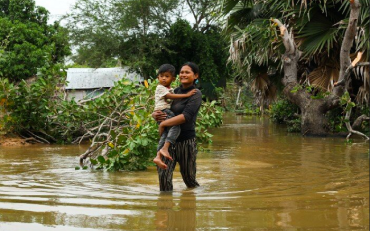The International Disability Alliance (IDA) welcomes the increased global attention to enhance inclusion of persons with disabilities in climate policies. IDA urges all States and the United Nations Framework Convention on Climate Change (UNFCCC) to take immediate, efficient measures to fulfill their obligations to ensure inclusion and participation of persons with disabilities in climate action decisions and processes.
The United Nations Climate Change Conference (COP26) hosted in Glasgow, Scotland, was a historic COP for persons with disabilities for many reasons. This was the first-time organizations of persons with disabilities could acquire observance status and had official delegations in the Conference of the Parties to the UNFCCC. We also witnessed media attention to the issue of accessibility during the conference generating much welcome debate about obligations of States and the United Nations to ensure equal participation for persons with disabilities.
It is true that the final outcome document of the conference included only one reference to persons with disabilities in its preamble. But we must acknowledge that the message of the disability movement was loud and clear. We must also remember that fulfillment of human rights, which is clearly emphasized in the COP26 outcome document include rights of persons with disabilities. We are also pleased to enjoy increasing support by governments. The clearest example is the Government of Finland who supported IDA delegation participation in COP26.
As the global network of over 1200 organizations of persons with disabilities, the International Disability Alliance pursued three main goals in COP26:
- First, to highlight the necessity of accessible and inclusive COP;
- Second to elaborate the impact of non-inclusive climate adaptation and climate mitigation policies on persons with disabilities; and
- Finally, to bring together organizations and groups advocating for disability-inclusive climate action in order to raise their voice in a strong and unified manner.
The first goal was accomplished to a certain extent with lots of media attention due to the lack of accessibility features at the COP26 venue. The UK Cabinet Office has been considering accessibility of the venue by organizing regular meetings with persons with disabilities before COP26. However, the actual experience proved that accessibility must be integrated into the building infrastructure. Short-term remedial steps may mitigate the challenges, but full accessibility requires long-term planning starting from the very first stages of design and procurement.
With regards to highlighting the interaction between climate action and the inclusion of persons with disabilities, COP26 was quite successful. The issue was discussed in a number of side-events and a statement was provided on behalf of the disability movement before the high-level segment.
For the first time in the history of COP, there was a Blue Zone side event approved by UNFCCC that focused on disability rights and inclusion within climate action. This event was titled Disability-Inclusive Climate Action: Challenges, Opportunities & Pathways and was hosted by McGill University’s Disability-Inclusive Climate Action Research Program, Human Rights Watch, the League of Women Voters, the International Disability Alliance, and Inclusion Scotland. The speakers included Jan Wahlberg, Climate Ambassador, Finish Ministry for Foreign Affairs who provided a powerful opening remark enumerating governments’ obligations to ensure inclusion of persons with disabilities in climate action.
There were two more side events, held in COP26’s Green Zone, that covered disability inclusive climate action. The first event was hosted by CBM UK, titled An inclusive planet: inclusion, mental health and climate change, focusedon the impacts of climate change on people with disabilities and how climate adaptation and resilience measures can be more inclusive, and incorporate proper consideration of mental wellbeing.
Hosted by The Global Disability Innovation Hub (GDI Hub) and Asian Development Bank (ADB), another side event titled Disability, Resilience and Inclusion in our Cities covered the topic of inclusive and accessible design for climate resilient cities.
Other mentions of disability rights and inclusion at COP26 included COP26’s Energy Day Opening Presidency Event, where a Just Transition Declaration was launched. The declaration stated that fully inclusive climate change mitigation and adaptation should benefit the most vulnerable through the more equitable distribution of resources, enhanced economic and political empowerment, improved health and wellbeing, resilience to shocks and disasters and access to skills development and employment opportunities. It should also display a commitment to disability inclusion and inclusion of other climate vulnerable groups.
Finally, the most significant achievement of COP26 for the disability movement was to bring together voices of persons with disabilities in this area. Climate action is now on the list of top priorities for many organizations of persons with disabilities and civil society working on disability inclusion. The paper launched by the International Disability Alliance and the Global Action on Disability (GLAD) Network is the best indication of this transformation.
No doubt we have a long challenging way ahead to realize disability-inclusive climate action. Governments are also not yet fulfilling their obligations under the United Nations Convention on the Rights of Persons with Disabilities. But, there is no doubt that we are on the right track and will definitely achieve much more in the forthcoming climate processes.
